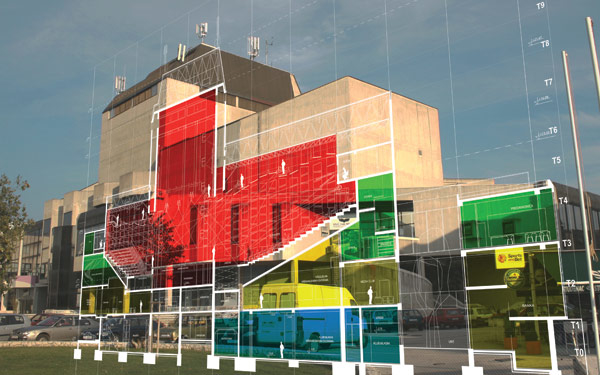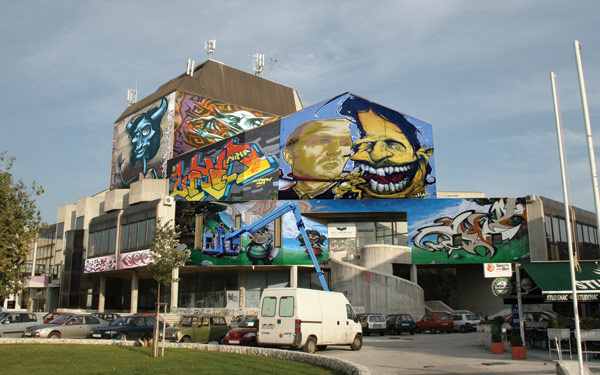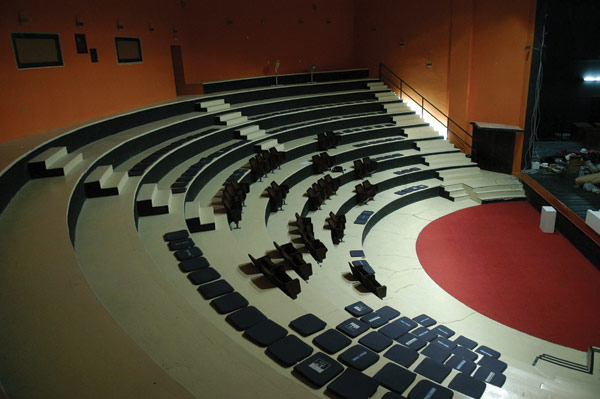Platforma 9,81 Dinko Peračić i Miranda Veljačić
Platforma 9,81 – Institut za istraživanja u arhitekturi
Platforma 9,81 je kolektiv arhitekata iz Hrvatske koji zajednički ili individualno kritički razmatraju i diskutuju prostorne i urbanističke pojave. Kao arhitekti, članovi kolektiva učestvuju u produkciji i transformaciji prostornog okruženja i ta njihova praksa je tesno isprepletena sa njihovim aktivnim učešćem u organizaciji – platformama za diskutovanje i istraživanje ekonomskih i kulturnih promena, želja i realnosti koje postaju određene putem arhitektonske transformacije.
Dinko Peračić and Miranda Veljačić, iz Platforme 9,81, fokusiraju istraživanje posebno na delove hrvatske obale na koje je uticao ubrzan turistički razvoj, kao i na druge kulturne i prostorne transformacije obale. Ostali projekti obuhvataju istraživanje naglih promena u Hrvatskoj tokom perioda tranzicije i aktivaciju mreže privremenih javnih prostora za kulturne aktivnosti u okviru napuštenih prostora. Baza udruženja nalazi se u Splitu, Hrvatska.
Prvobitna namena: Objekat je projektovao Frane Grgurević 1977. godine. Prvobitno je zamišljen kao Dom socijalističke omladine, jedan veliki i multifunkcionalni kompleks. Izgradnja je počela 1979. godine i objekat je pripreman za događaj Mediteranske igre koji je održan iste godine. Međutim, nakon završetka osnovnih radova, 1984., dalji radovi su obustavljeni i objekat, koji je samo delimično pušten u rad, je sledećih dvadeset godina predstavljao veliki finansijski, politički i čak bezbednosni problem grada.
Uprava: 1994. godine organizovan je Art Squat događaj, trodevni program koncerata i performansa, zbog kojeg je objekat delimično očišćen. Između 1997. i 2005. godine centrom je upravljao Kulturni centar za mlade. U objektu su, takođe, bili smešteni prostori prve privatne TV stanice u Hrvatskoj – TV Marjan. Nakon šestomesečne medijske kampanje, Koalicija udruženja mladih (KUM), kojoj je pripadalo šest organizacija, uz saglasnost opštinskih organa, preselila se u podrum objekta. Od 2005. godine objektom upravlja Multimedijalni kulturni centar. Pored ovih, drugi stalni korisnici objekta su: Hram – Kulturna alternativa mladih; Bioskop klub Split; Splitski filmski festival; Baletski studio; Igrano dramsko pozorište. Povremeni korisnici objekta su: HULU Split, World Press Photo, Pričigin festival, Platforma 9.81, Akademija umetnosti iz Splita – odsek za film i video, Split Guitar Festival, Hrvatsko narodno pozorište u Splitu, Udruženje arhitekata Splita, Dopust – Dani otvorenog performansa.
Program: KUM organizacija, koristeći lična sredstva, reorganizovala je potpuno neupotrebljiv prostor i otvorila je klub Kocka namenjen koncertima, performansima, radionicama i sl. Kasnije je u prostoru postavljen skejt park, i kao i KUM, u prostor su se uselile druge omladinske inicijatrive. Na inicijativu Platforme 9.81, na čelu sa MCC, pokrenut je obiman program – transformacija objekta u multimedijalni kulturni centar sa hibridnom upravom i konstantno angažovanje radi povezivanja postojećih inicijativa i podsticanje i jačanje drugih programa u prostorima Doma. Zapušteni i nadovršeni objekat mimo očekivanih institucionalnih okvira, počeo je da obavlja funkciju sličnu onoj koja je prvobitno namenjena, ali u objektu koji je potpuno drugačiji u smislu upravljanja, programa i prostora.
Revitalizacija: Korpulentna zgrada Doma mladih je, u pogledu programa i prostora, detaljno definisana i završeni su radovi na spoljnjem omotaču. Svaka radikalna promena strukture sadržaja bila je teško izvodljiva. Jezgro prostorne konfiguracije predstavlja interesantan kompleks scena sa dvostranim amfiteatarskim auditorijumom koji ima 350 i 650 mesta, sa scenskom kulom visine 23,5m koja je danas veoma impresivna. Dom mladih, takođe, sadrži mnoge druge prostore koji se postepeno kolonizuju i koriste za različite regularne ili ad hoc događaje. U toku je postepeno renoviranje i prilagođavanje, prilično neobično zbog toga što se radovi obavljaju paralelno sa korišćenjem prostora i ceo objekat je već u ovom trenutku potencijalno upotrebljiv prostor. Projekat ima za cilj formiranje bazičnih uslova za održavanje kulturnih programa i njihovo konstantno usavršavanje. Svi novi elementi (osim onih uključenih u osnovnu strukturu) instalacije, particije, opremanje, oznake, dekoracija i rekviziti postavljeni su u prostor tako da se mogu pomeriti, zameniti, dopuniti i prilagoditi. Shodno tome, veliki deo prostora može biti u potpunosti ispražnjen, reorganizovan ili raspoređen prema novim potrebama u relativno kratkom roku. Cilj objekta je da služi kulturnim događajima i životu unutar objekta. Svi instalirani elementi su podređeni ovom cilju.
Koncept projekta je reorganizacija prostora i procesa korištenja. Postojeći, nikad završen, Dom socijalističke omladine iz 1978, bio je zamišljen kao centralno organiziran prostor teatra sa strogo odvojenim prostorima za publiku i osoblje i velikim stalnim ansamblom (kao HNK). Naš projekt zgradu tretira kao raspoloživi prostor koji je fragmentiran u niz manjih prostora u kojima se smještaju kulturne inicijative, ne za stalno nego prema projektima. U zgradu se ulažu minimalni novci polaganim tempom ali usprkos tome u njoj se gradi kulturni program u trenutačno raspoloživim uvjetima. Vrlo često kulturni programi sami uređuju i grade prostore koje koriste. Od centralnog teatra to postaje kulturni kompleks. Istovremeno ustanova koja upravlja zgradom je mala, ali gradimo jedan oblik hibridne institucije koja okuplja razne incijative koje zgradom upravljaju i koriste je.
„Većina postojećih zgrada traži svoj novi život, prenamjenu, prilagodbu, ponovno korištenje. Dom mladih je takav primjer u kojem smo veliki napušteni javni objekt, projektiran po jednom principu, prilagodili današnjim dinamičnim kulturnim potrebama. Prioritet je da prostor živi, da se u njemu stvara suvremena urbana scena. Zgrada je samo infrastruktura za događanja. Mi smo tu da ju zajedno sa korisnicima neprestano unapređujemo, mijenjamo i prilagođavamo.“ Platform 9.81 Dinko Peračić and Miranda Veljačić
Platforma 9,81 – an association for architectural research
Platforma 9.81 are a collective of architects from Croatia engaged collaboratively and independently in the critical rethinking and debate of urban planning and public space. Working as architects they take part in the production and transformation of the built environment, yet this practice is closely entwined with their active involvement in the organization of platforms for discussion and research into economic and cultural shifts, desires and realities that become tangible through architectural transformations.
Dinko Peračić and Miranda Veljačić, from Platforma 9.81, focus in their research particularly on the Croatian coastline driven by rapid tourist development, as well as other cultural and spatial transformations of coastlines. Their other projects include an investigation into the swift changes in Croatia during the perod of transition and an activation of a network of temporary public spaces for cultural activities in abandoned premises. They are based in Split, Croatia.
Original purpose: It was designed in 1977, the architect being Frane Grgurević. Originally, it was conceived as the House of Socialist Youth, a large and multi-purpose complex. The construction was started in 1979 to be used in the Mediterranean Games held in the same year. However, after the completion of the shell, in 1984 the works were halted, and the building, only put to use in a small part, was for the next twenty years a major financial, political and even security problem for the city.
Principals: In 1994 the Art Squat was organised, a three-day programme of concerts and performances for the purpose of which the premises were partially cleaned. From 1997 to 2005 the Centre was managed by the Youth Culture Centre. The premises also housed the first private TV station in Croatia, TV Marjan. After a six-month media campaign, the Coalition of Youth Associations (abbreviation KUM), made up of six organisations, moved, with the consent of the municipal authority, into the basement. Since 2005 the building has been managed by the Multimedia Culture Centre. As well as these, the other permanent users are: Hram – Youth Culture Alternative; Split Cinema Club; Split Film Festival; the Ballet Studio; Playdrama Theatre. Occasional users are: HULU Split, World Press Photo, Pricigin Festival, Platforma 9.81, Split University Art Academy – Film and Video Department, the Guitar Festival, Split Croatian National Theatre, Split Association of Architects, Dopust – Open Performance Days.
Programme: With its own resources, KUM put in order the totally unusable space and opened up the Kocka Club, meant for concerts, performances, workshops and so on. Later a skate park was laid out in the space, and as well as KUM, other youth initiatives moved in. At the initiative of Platforma 9.81, and led by the MCC, an extensive programme was launched for putting the building to rights, its transformation into a multimedia culture centre with a hybrid management and constant engagement linking existing initiatives and the encouragement and reinforcement of other programmes in the spaces of the Centre. This meant that the neglected and unfinished Youth Centre, bypassing the expected institutional frameworks, started to perform a function similar to that originally intended for it, although on premises that were completely different in terms of management, programme and space.
Revitalisation: The corpulent building of the Youth Centre is in terms of programme and space precisely defined and its shell was completed. Any radical change of the contents was hardly feasible. The core of the spatial configuration is an interesting stage complex with a two-sided amphitheatric auditoria capable of seating 35 0 and 650, with a stage tower 23.5 m high, which today, in its bareness, is rather impressive. The Youth Centre also contains many other spaces, which are gradually being colonised and used for various regular or ad hoc events. Underway is a gradual adjustment and renovation, rather unusual in that the works are going on in a slow rhythm hand in hand with the use of the space, irrespective of whether it is fully completed or not, and the whole building is already at this moment a potential usable space. The project is aimed at the creation of the basic conditions for the holding of cultural programmes and their constant improvement. All the new elements (save those incorporated into the basic structure), installations, partitions, furnishing, signing, decoration and requisites are put down into the space in such a way as to be moveable, replaceable, extendable and adjustable. Accordingly, the major part of the space can be completely vacated, reorganised or reassigned for new needs in a relatively short period. The aim is to serve the cultural events and life in the building. All the elements installed are subordinated to this aim.
The concept of the project implies the reorganization of space and its usage. The existent, never completed, House of Socialist Youth, built in 1978, was conceived as a centrally organized theatre space with public and staff spaces strictly separated and with a large permanent ensemble area like in The Croatian National Theatre. Our project treats the building as an available space which is fragmented into several smaller areas for current culture events. Despite gradual and small investments, works on the building and its cultural program continues in present conditions. Organizing cultural events often means defining and constructing the space for each particular event. Building transforms from the central theatre space into a cultural complex. Establishment that runs the building is small, but we are trying to make a form of hybrid institution that will bring together various initiatives that can manage and use the building.
“Most of the existing buildings require a new life, reorganisation, adaptation, re-usage. The Youth Centre is an example of large deserted public building, designed on different principle, being transformed into space which is adapted to today’s dynamic cultural needs. The priority is to make the space alive, to form the space which can insure creation of the contemporary urban scene. The building is only the infrastructure for events. We are here, together with users, to constantly upgrade, change and adapt this place. “












